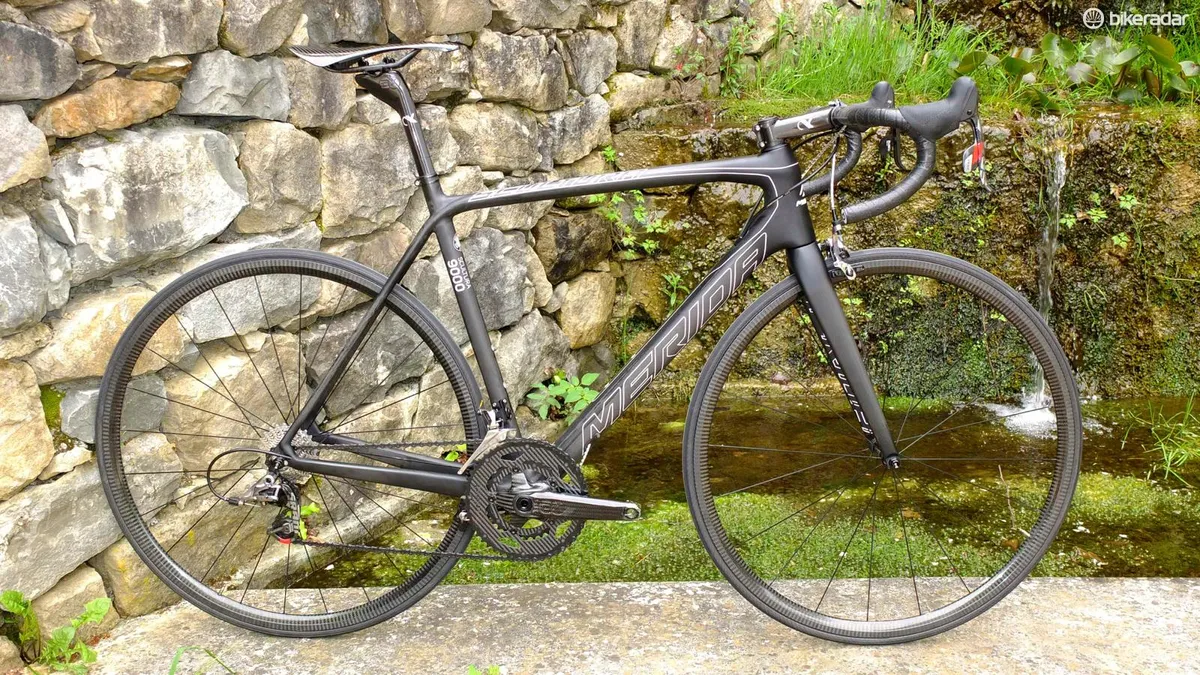At the start of the 2015 Giro d'Italia, Taiwanese bike maker Merida announced a 680g Scultura 9000 frame, which the company built into a 4.56kg / 10.05lb bike with SRAM Red, Tune Skyline wheels and AX Lightness parts. With this Scultura 9000 LTD machine, Merida claims it now has the world's lightest production road bike, just nosing past the 690g Trek Émonda that weighs 4.65kg/10.25lb with a similar build.
Sponsor of the Lampre-Merida WorldTour team, Merida also launched the Scultura 4, which is the more practical frame that Lampre-Merida will be racing. A year after unveiling the Reacto aero machine, Merida redesigned the Scultura for better aerodynamics, wider tyres and a longer, lower geometry. The new Scultura 4 frame weighs a scant 750g, still quite light by anyone's standards.
Merida first launched the Scultura in 2006 as a monocoque carbon frame. By 2008, Merida had the frame weight down to 830g with size-specific lay-ups. Version 3 in 2012 gained some vibration damping, a BB386 EVO bottom bracket, and more aggressive handling with short, 400mm chainstays. But this model wouldn’t accept tyres wider than 23mm.
With current bikes aiming to be efficient, aero and comfortable, Juergen Falke, Merida’s German head of product design, said Merida's benchmark bikes throughout the Scultura 4 design process were the Cannondale SuperSix Evo, Scott Addict, Cervélo R5, Specialized S-Works Tarmac, Trek Émonda, Focus Izalco Max and Canyon Ultimate SLX. Version 4’s targets were to maintain stiffness and aggressive handling while improving compliance, tire clearance and aerodynamics in a frame weight of around 750g.
The new bike’s geometry is more aggressive, meaning a shorter head tube than the previous model, which was too tall at the front for most pros' positions. For example, the new 54cm frame has a 155mm head tube with a 56cm top tube.

The new Merida Scultura 4 is what Lampre-Merida is racing at the Giro d'Italia. The Scultura 4 frameset is longer and lower than before, at a still very light 750g for the frame
Wind tunnel testing with mannequin legs and CFD analysis helped create an accurate picture of turbulence around the frame, and helped development, Falke said. The frame’s tube cross-sections are based on a NACA0028 airfoil wing profile, but heavily truncated to save weight and drag – essentially shortened Kamm Tails. The frame also has bridgeless seatstays and a rear direct-mount brake hidden beneath the chainstays.
Falke says that aero performance is most crucial at the head tube and down tube, and it’s here the Scultura is now much improved, with drag figures halfway between the old Scultura and the very aero Reacto. For vibration damping, Merida uses what it calls 'Bio Fibres', which are sandwiched within the carbon layup. Merida hand-lays 400 individual pieces of pre-preg carbon and Bio Fibre material into moulds, with each frame taking 11-14 hours to build, Falke said.
Merida is convinced that 750g frames mark the practical limit of current carbon frame manufacturing technology, when building in mass-production facilities, as well as the sensible limit to maximise frame durability during the rough and tumble of day to day pro racing. Falke said that frames such as Cervélo’s exclusive RCA are exceptional, and built in clean lab-type conditions. The Scultura’s frame has wall thicknesses as low as 0.4mm with large cross-sections that are essential to gain the desired stiffness figures.
All that said, Merida still debuted the Scultura 9000, a 680g frame. Built up with SRAM Red and the new DT Swiss Mon Chasseral carbon clinchers, the Scultura 9000 weighs 5.8kg complete, compared to the 6.6kg Scultura Team. Lighter still is the Scultura 9000 LTD complete bike, which Merida claims to be the lightest production bike now available. Using the same Scultura 9000 frameset, and components from Tune and AX Lightness, there will be only one production run of the bike, with numbers depending on demand. The rideable example hanging on a scale at Merida's launch event at the Giro weighed just 4.56kg / 10.05lb, or about 100g lighter than Trek’s Émonda, but Merida said it could be made lighter still. Complete specification will include Tune Skyline wheels; SRAM Red; AX Lightness crank, bar, stem, seatpost and saddle; Vittoria tyres (the displayed model had Tufos) and Jagwire cables.
Pricing is yet to be announced.

The Scultura 9000 with a SRAM Red build and newDT Swiss Mon Chasseral carbon clinchers








